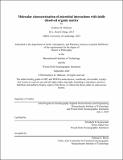Molecular characterization of microbial interactions with labile dissolved organic matter
Author(s)
Halloran, Kathryn H.
DownloadThesis PDF (2.748Mb)
Advisor
Kujawinski, Elizabeth B.
Terms of use
Metadata
Show full item recordAbstract
Marine microbes produce and consume labile dissolved organic matter (DOM), generating a carbon flux with significant implications for global carbon cycling and microbial ecosystems. Intracellular measurements of biological activity cannot fully capture microbial interactions with dissolved carbon. Better understanding this carbon flux thus requires direct and compound-specific characterization of metabolites, the small organic biomolecules that make up labile DOM. However, these measurements are challenging due to low metabolite concentrations, high ambient salt concentrations, and the complexity of labile DOM. More complete characterization of dissolved metabolites is therefore a standing challenge in the field. This in turn leaves many open questions with respect to the specificity of microbe-DOM interactions and the biotic and abiotic drivers of those interactions. This thesis addresses those challenges and questions. In Chapter 2, I explore the compound-specific uptake of metabolites by the copiotrophic gamma-proteobacterium Alteromonas macleodii, with a focus on metabolites derived from the cyanobacteria Prochlorococcus. I find that Alteromonas grows on 3-methyl-2- oxobutanoic acid, a valine intermediate, but not on the other cognate branched chain amino acid intermediates. This substrate selectivity is likely driven by transporter specificity. The distinct fate of these structurally similar molecules emphasizes the importance of compound-specific characterization of labile DOM. To expand our ability to make these compound-specific measurements, in Chapter 3 I develop a method for derivatizing carboxylate-, carbonyl-, and phosphate-containing molecules via aniline derivatization, solid phase extraction, and liquid chromatography-tandem mass spectrometry (LC-MS/MS). This method is able to quantify 51 different metabolites dissolved in seawater, 25 of which could not be detected previously, with pM to nM detection limits. I verify the utility of this method by applying aniline derivatization to phytoplankton culture filtrates and field samples. Additionally, I show that where dissolved metabolites can be quantified by multiple methods, the measurements obtained by aniline derivatization are in good agreement with measurements yielded by other methods. Finally, in Chapter 4 I use aniline derivatization to characterize the diel variability of labile DOM produced by phototrophic microbes. Here, I apply aniline derivatization to filtrate from cultures of Prochlorococcus grown under 24-hour diel light/dark conditions and sampled every two hours. I find that Prochlorococcus cells not only release metabolites into solution, but also take those metabolites up again, with diel rhythmicity. Together, this thesis shows that microbe-DOM interactions can be remarkably subtle and complex; expands our ability to quantify the metabolites that make up labile DOM; and demonstrates the importance of directly quantifying these dissolved metabolites to fully characterize microbial ecology and carbon cycling in the ocean.
Date issued
2024-09Department
Joint Program in Oceanography/Applied Ocean Science and Engineering; Massachusetts Institute of Technology. Department of Earth, Atmospheric, and Planetary SciencesPublisher
Massachusetts Institute of Technology